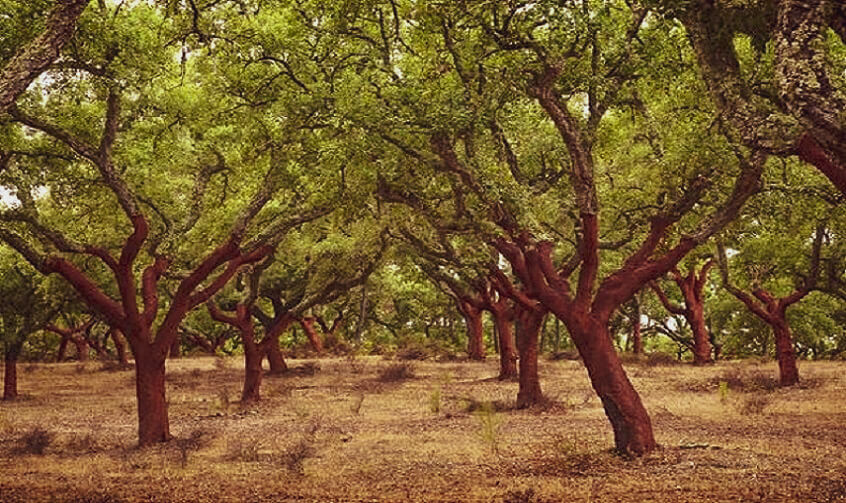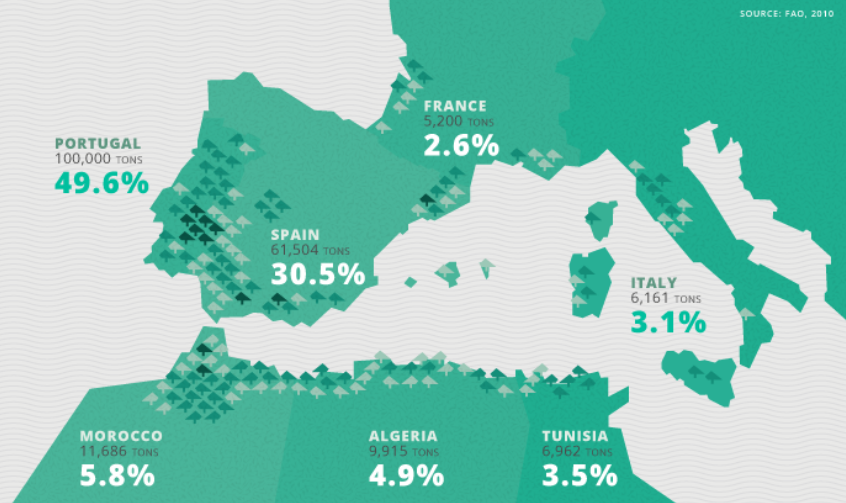Where Does Cork Come From?
Cork is the outer bark of the Cork Oak tree, Quercus Suber. Cork oaks are found in forests surrounding the Mediterranean Sea. Portugal is the world's largest cork producer, but Cork Oaks are also cultivated in Spain, Italy, France, Morocco, Tunisia, and Algeria.
Cork is easily stripped from the tree from May to August by skilled cork harvesters, and the tree itself is not harmed in any way. The tree forms new protective layers of cork quickly after its bark is removed.
And the best part- stripping the cork bark is actually beneficial to the health of the tree, as well as the environment! This is because the cork oak is able to absorb much higher levels of carbon dioxide after the bark is harvested
Cork Oak trees are incredibly important to the ecosystems and the environment in these regions, as they store and retain water and nutrients in their roots, and therefore act as a watershed for the surrounding area and prevent desertification.
The cork oak forests also are vibrant with biodiversity. Cork oak forests are home to many rare species of plant, fungi, and animals, some of which are found nowhere else in the world. According to the Cork Forest Conservation Alliance, some of these are highly endangered species and rare birds.
As these cork oak trees play such an important role in the preservation of the environment, Portugal has taken drastic action to protect them. In Portugal, it is illegal to cut down a cork forest, and it is considered a serious offense.
This is because with cork oaks, there is no need to cut down the tree in order to harvest the outer bark. Cork is the only type of tree bark that can be removed from a tree without injuring the tree, and cork oaks can live up to 250 years.
Why Cork Is One Of The World's Most Incredible Raw Materials
Cork is a completely natural, renewable plant bark, with qualities that make it one of man's best friends in the plant kingdom.
Cork production does not involve cutting down trees to harvest the bark, and therefore is a process regarded as one of the most sustainable forestry practices in the world by the Forest Stewardship Council.
We consider cork to be a masterpiece of nature, a plant bark with inherent superpowers unique to the cork oak. Here are some of the reasons why:
Collapsible content
Water Repellent
Cork cells contain a waxy, rubbery substance called Suberin, which is highly hydrophobic, meaning that it strongly repels water.
Because of Suberin, water cannot penetrate into the cells of the cork bark, making cork products incredibly water-resistant, preventing the growth of mold, mildew, and moisture as well.
Fire Retardant
Cork is a material that undergoes a very slow process of combustion. It is resistant to catching on fire even when exposed to high temperatures.
If it does happen to catch on fire, it does not produce flames, and releases a non-toxic smoke when burning. Cork forests act as a protective force against wildfires.
Sound Insulator
Cork contains gas in between its cells in small impermeable bubbles, which are separated from each other by the Suberin contained within the cells.
This gas makes it so that cork has a low conductivity of noise and vibration, which makes it perfect for use in your green home building.
Thermal Insulator
The gas contained in the small inter-cellular spaces, within the honeycomb structure, give cork a low thermal conductivity, and make it able to withstand a wide range of temperatures.
This is what makes cork such a great material for housing and flooring insulation, as well as bags, wallets, and jewelry.
Shock Absorption
Because of cork’s unique cellular structure, cork cells can be compressed to about 15% of their original size, and then slowly come back to their previous shape and volume. This property makes cork able absorb shock, and also makes it practically indestructible!
Anti-Allergy
Most allergies are caused due to mold and particles found in water, dust and dirt. Because of cork’s water-repellent properties, and because it doesn’t absorb dust and dirt, microbes such as mold and bacteria cannot enter into the cells. This makes cork and products made of cork highly non-allergenic.
Cork Oaks Create A Carbon Dioxide Sink
Cork forests remove a huge amount of carbon dioxide from the atmosphere, which is why these forests are considered carbon sinks.They consume nearly 14 million tons of carbon dioxide per year. Cork oaks actually have an improved ability to absorb CO2 during their natural regeneration after the cork bark has been harvested!
Cork Oaks Prevent Desertification
The roots of the cork oak are capable of storing a large amount of rainwater, forming watersheds, and absorbing nutrients from deep within the earth. This is why cork oaks prevent against soil erosion, which eventually leads to desertification. Hence, there is an expression that goes “Whoever cares for their grandchildren plants a cork oak.”
Cork Oaks Protect Endangered Animals
The acorns, which grow on cork oaks, provide food for countless animal species who call these forests home. There are a multitude of endangered species who live in the cork forests, which are among the most important ecosystems in the world in terms of biodiversity.
100% Recyclable
No cork is ever wasted from the cork harvest, as cork of all ages has different uses, from young cork used for flooring, insulation, and sustainable fashion, to the oldest cork which is used for wine stoppers. All cork is entirely recyclable, and after its first usage, it can be ground into pieces to be used for making new items.



